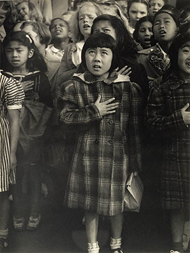Grades/Level: Lower Elementary (K–2), Upper Elementary (3–5)
Subjects: Visual Arts, English–Language Arts, History–Social Science
Time Required: 2–Part Lesson
2 class periods
Author: J. Paul Getty Museum Education Staff
Permissions: 
The lesson plan and downloadable materials on this page are licensed under a Creative Commons Attribution 4.0 International License. |
 |
|
 |
• Reproduction of Pledge of Allegiance, Rafael Weill Elementary School, San Francisco by Dorothea Lange
• Background Information and Questions for Teaching about the photograph (click on the thumbnail of the photograph below)
• Internet access
• Reproduction of Dorothea Lange's photograph Tagged Girl from the Freedom Voices Web site (optional)
• Student Handout: Helene's Journey
• Pencils
• The Children of Topaz: The Story of a Japanese-American Internment Camp Based on a Classroom Diary by Michael O. Tunnell and George W. Chilcoat (New York: Holiday House, 1996)
• Flowers from Mariko by Rick Noguchi, Deneen Jenks, and Michelle Reiko Kumata
(New York: Lee and Low Books, 2001) |
 |
 |
 |
Download the complete lesson by clicking on the "download this lesson" icon above.
Glossary Terms:
Words in bold on these pages and in the lesson are defined in the glossary for this curriculum (see "For the Classroom" links above).
|
 |
 |
 |
| Pledge of Allegiance, Rafael Weill Elementary School, San Francisco, Dorothea Lange, 1942 |
 |
|
 |
Common Core Standards for English Language Arts
Grades K–5
SPEAKING AND LISTENING
K.1 Participate in collaborative conversations with diverse partners about kindergarten topics and text with peers and adults in small and larger groups.
K.4 Describe familiar people places, things, and events, with prompting and support, provide additional detail.
1.3 Ask and answer questions about what a speaker says in order to gather additional information or clarify something that is not understood.
1.6 Produce complete sentences when appropriate to task and situation. (See grade 1 Language standards 1 and 3 for specific expectations.)
2.4 Tell a story or recount an experience with appropriate facts and relevant, descriptive details, speaking audible in coherent sentences.
3.1 Engage effectively in a range of collaborative discussions (one-on-one, in groups, and teacher-led) with diverse partners on grade 3 topics and texts, building on others' ideas and expressing their own clearly.
4.1 Engage effectively in a range of collaborative discussions (one-on-one, in groups, and teacher-led) with diverse partners on grade 4 topics and texts, building on others' ideas and expressing their own clearly.
4.3 Identify the reasons and evidence a speaker or media source provides to support particular points.
5.1 Engage effectively in a range of collaborative discussions (one-on-one, in groups, and teacher-led) with diverse partners on grade 5 topics and texts, building on others' ideas and expressing their own clearly.
5.3 Summarize the points a speaker or media source makes and explain how each claim is supported by reasons and evidence, and identify and analyze any logical fallacies.
READING
Literature
K.1 With prompting and support, ask and answer questions about key details in a text.
K.4 Ask and answer questions about unknown words in a text. (See grade K Language standards 4–6 for additional expectations.)
1.1 Ask and answer questions about key details in a text.
1.4 Identify words and phrases in stories or poems that suggest feelings or appeal to the senses. (See grade 1 Language standards 4–6 for additional expectations.)
2.1 Ask and answer such questions as who, what, where, when, why, and how to demonstrate understanding of key details in a text.
2.4 Describe how words and phrases (e.g., regular beats, alliteration, rhymes, repeated lines) supply rhythm and meaning in a story, poem, or song. (See grade 2 Language standards 4–6 for additional expectations.
3.1 Ask and answer questions to demonstrate understanding of a text, referring explicitly to the text as the basis for the answers.
3.4 Determine the meaning of words and phrases as they are used in a text, distinguishing literal from nonliteral language.
4.1 Refer to details and examples in a text when explaining what the text says explicitly and when drawing inferences from the text.
4.4 Determine the meaning of words and phrases as they are used in a text, including those that allude to significant characters found in mythology (e.g., Herculean).
5.4 Determine the meaning of words and phrases as they are used in a text, including figurative language such as metaphors and similes.
For more national and California state standards for this curriculum, refer to the charts found in the links at the top right of this page.
|
 |

|
 |



